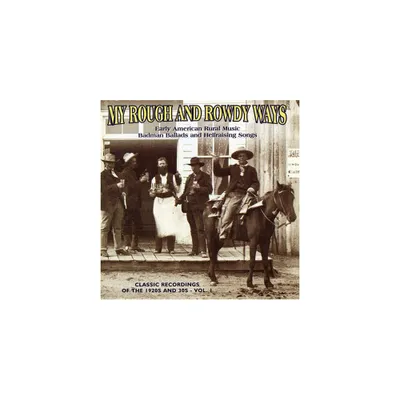Home
My Rough and Rowdy Ways, Vol. 1
Loading Inventory...
Barnes and Noble
My Rough and Rowdy Ways, Vol. 1
Current price: $19.99


Barnes and Noble
My Rough and Rowdy Ways, Vol. 1
Current price: $19.99
Loading Inventory...
Size: OS
*Product Information may vary - to confirm product availability, pricing, and additional information please contact Barnes and Noble
A disc of classic recordings is a rarity, but that's exactly what this is. Some of the performers are well known people, like
Clarence Ashley
,
Dock Boggs
Uncle Dave Macon
, and
Tommy Johnson
. Others, like the
Haywood County Ramblers
, are far from household names, but that doesn't mean their songs are lesser creations. And these
ballads
of bad men, hell raisers, violence, and drinking are the stuff of legends, like
"Frankie"
by the
Dykes Magic City Trio
, a version of
"Frankie and Johnny"
by a group reminiscent of the
Carter Family
. It's interesting that the performers on these songs from the '20s and '30s are both black and white, and the music sounds remarkably similar -- a clear indication that prejudice didn't extend everywhere at the time, and that music was colorblind. From a time when American rural song was still a strong musical force -- before
Tin Pan Alley
and commercialization had changed everything --
"Little Sadie"
and
"Viola Lee Blues"
come across the years with complete crispness, while the banjo style of
can be heard as an influence on so many who followed. But these pieces also come from the cusp, when urban culture was about to take over, and songs like the
Allen Brothers
'
"Prisoner's Dream"
would be replaced by other tunes. In fact, the one piece here that offers any kind of continuity is a version of
"Stack-O-Lee"
from the
Fruit Jar Guzzlers
, although their version seems hopelessly naive and country compared to others that would come later. This is, as it's meant to be, a collection that's very much of its place and time. But since they both represent a crossroad, it's a great place and perfect time in the development of American music. ~ Chris Nickson
Clarence Ashley
,
Dock Boggs
Uncle Dave Macon
, and
Tommy Johnson
. Others, like the
Haywood County Ramblers
, are far from household names, but that doesn't mean their songs are lesser creations. And these
ballads
of bad men, hell raisers, violence, and drinking are the stuff of legends, like
"Frankie"
by the
Dykes Magic City Trio
, a version of
"Frankie and Johnny"
by a group reminiscent of the
Carter Family
. It's interesting that the performers on these songs from the '20s and '30s are both black and white, and the music sounds remarkably similar -- a clear indication that prejudice didn't extend everywhere at the time, and that music was colorblind. From a time when American rural song was still a strong musical force -- before
Tin Pan Alley
and commercialization had changed everything --
"Little Sadie"
and
"Viola Lee Blues"
come across the years with complete crispness, while the banjo style of
can be heard as an influence on so many who followed. But these pieces also come from the cusp, when urban culture was about to take over, and songs like the
Allen Brothers
'
"Prisoner's Dream"
would be replaced by other tunes. In fact, the one piece here that offers any kind of continuity is a version of
"Stack-O-Lee"
from the
Fruit Jar Guzzlers
, although their version seems hopelessly naive and country compared to others that would come later. This is, as it's meant to be, a collection that's very much of its place and time. But since they both represent a crossroad, it's a great place and perfect time in the development of American music. ~ Chris Nickson


















